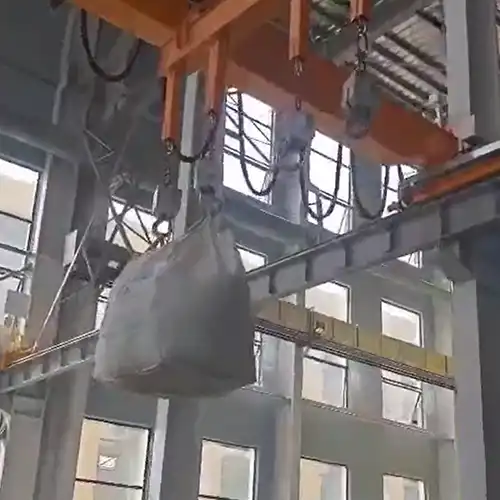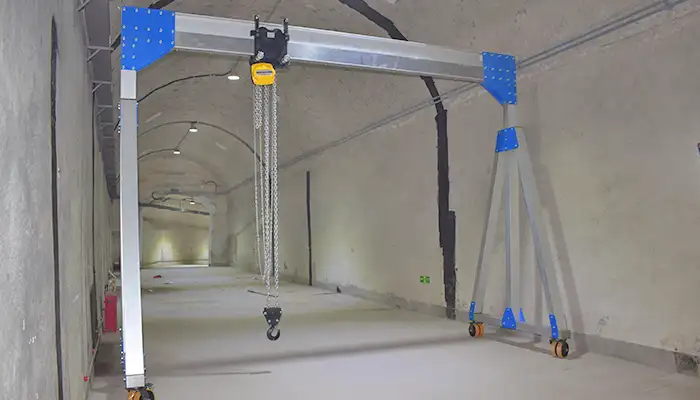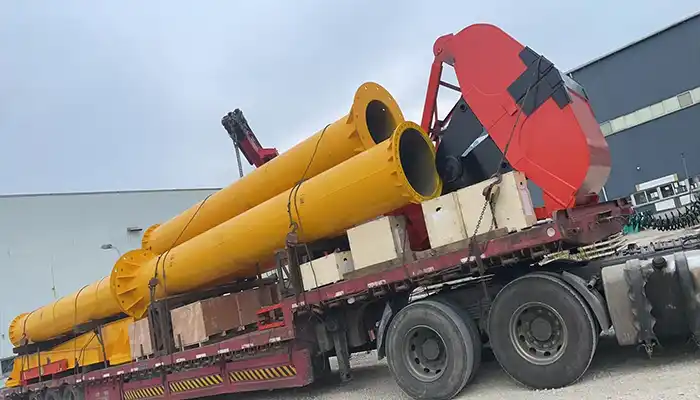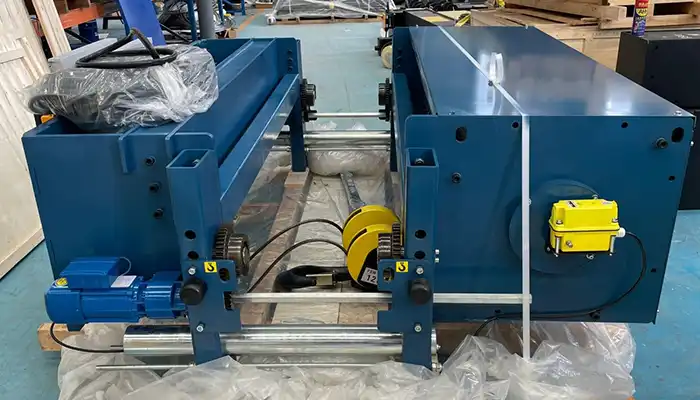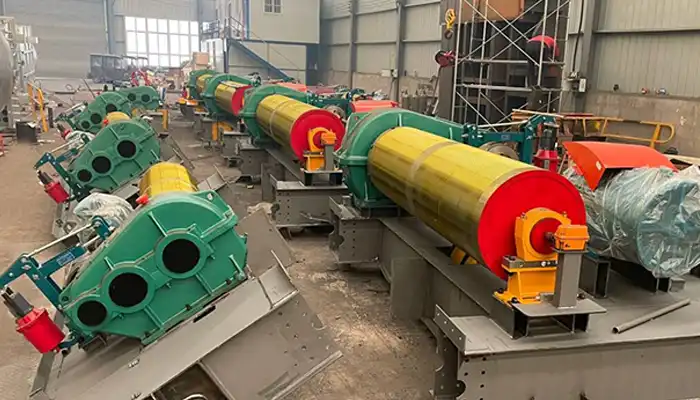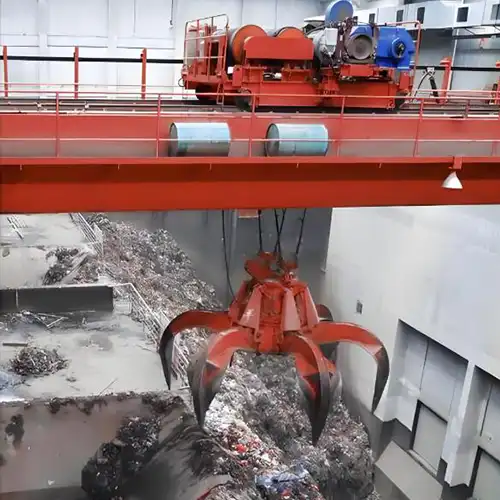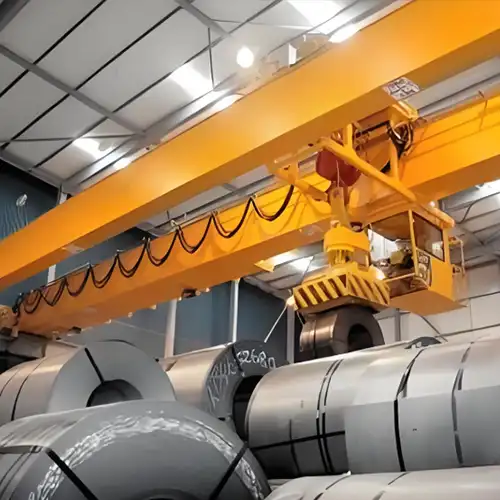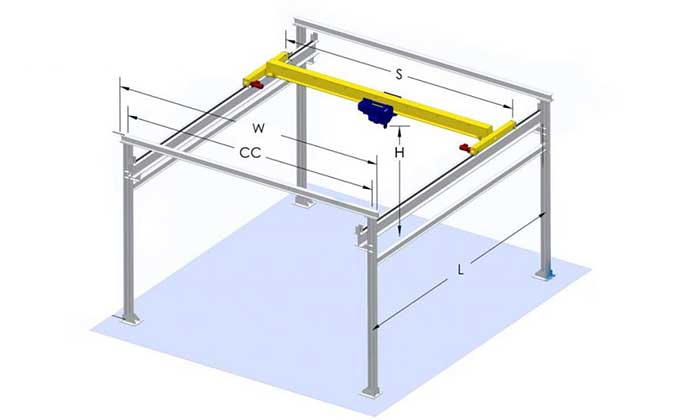Overhead Bridge Crane 20-50 Ton with Automatic Release Hook
20-50 ton overhead bridge crane with automatic hooks improves PTA bulk bag handling, reduces labor, and enhances workplace safety.
Category: Featured
Your Trusted Overhead Bridge Crane Manufacturer & Supplier
Overhead Bridge Cranes (20-50 Ton) with Automatic Hooks
Customized Overhead Bridge Crane for Reducing Labor and Improving PTA Handling
Introduction:Overview of Overhead Bridge Cranes (20-50 Ton)
What are Overhead Bridge Cranes?
Overhead bridge cranes are lifting systems that use a hoist attached to a bridge supported by two girders. These cranes move materials along horizontal and vertical paths, providing flexibility in moving heavy loads across a workspace. They are designed to lift and transport large, heavy objects safely and efficiently.
Why Use Overhead Bridge Cranes for PTA Handling?
In industries dealing with materials like PTA, overhead bridge cranes are indispensable. PTA bulk bags, often weighing several tons, require precise handling to avoid damage. The 20-50 ton cranes are ideal because they provide the power needed for heavy lifting, making them perfect for managing PTA material in bulk.
Choosing the Right Capacity (20-50 tons)
When selecting a crane, it's important to match the crane's capacity to the load. A 20-50 ton capacity crane is perfect for PTA bulk bags, ensuring that the crane can handle the load without any risk of overloading. Choosing the right capacity ensures safety and operational efficiency, preventing both wear and tear on equipment and potential accidents.
Significance of PTA Handling
What is PTA and Why is it Important?
PTA (Purified Terephthalic Acid) is a critical material in the production of polyester, used in fabrics, plastic bottles, and films. Its importance in industries like textiles and packaging makes efficient PTA handling a must. Without efficient handling systems, moving and storing PTA can become cumbersome and hazardous.
Challenges of Handling PTA Bulk Bags
PTA is typically delivered in large, heavy bulk bags. These bags can be challenging to move manually due to their weight and size. Improper handling can cause delays, material waste, or even injury to workers. That's where overhead bridge cranes come in, offering a safe, efficient solution to handle these bulky loads.
Introduction to Automatic Hooks
What are Automatic Hooks?
An automatic hook is a crane attachment designed to automatically latch onto and release loads. When the crane is in position, the automatic hook engages with the lifting loop, securing the load without the need for manual intervention. Once the load is in place, the hook releases it automatically.
Why Use Automatic Hooks for PTA Handling?
Incorporating automatic hooks into crane operations significantly improves efficiency and safety. Here's how:
- Speed: Automatic hooks reduce the time spent on attaching and detaching loads.
- Safety: By eliminating manual handling, the risk of injury and human error is reduced.
- Efficiency: With faster loading and unloading, operations can run smoothly with fewer delays, increasing productivity.
Using automatic hooks in PTA handling streamlines the process and makes material movement faster, safer, and more cost-effective.

20 to 50 Ton Overhead Bridge Cranes Options for PTA Handling
When handling PTA (Purified Terephthalic Acid) in bulk, choosing the right overhead bridge crane is essential to ensure efficiency, safety, and reliability. Here's a breakdown of two popular options: Hoist Trolley Overhead Bridge Cranes and Open Winch Overhead Bridge Cranes, both with a capacity range of 20 to 50 tons, ideal for PTA handling.
Hoist Trolley Overhead Bridge Cranes
Key Features:
- Hoist Trolley Design: The hoist is mounted on a trolley that runs along the crane's bridge. This design allows for smooth, controlled movement of loads.
- High Capacity: Hoist trolley cranes can handle PTA bulk bags with a lifting capacity ranging from 20 to 50 tons.
- Space Efficiency: The hoist trolley design maximizes the available vertical space, making it ideal for facilities with height restrictions.
- Precision Lifting: These cranes offer precise load control, which is essential when handling heavy PTA bulk bags, minimizing the risk of spills or damage.
Why Choose Hoist Trolley Cranes for PTA Handling?
- Cost-Effective and Reliable: Hoist trolley cranes are often more affordable compared to more complex designs, but they still provide excellent performance in handling PTA materials.
- Versatility: They are ideal for smaller to medium-sized facilities where precise, controlled lifting and space optimization are key concerns.
- Efficiency: Their smooth movement ensures that PTA bulk bags can be lifted and transported with minimal delays.
Open Winch Overhead Bridge Cranes
Key Features:
- Open Winch Design: In an open winch crane, the winch is mounted on the bridge but is not enclosed in a housing, providing easy access and maintenance.
- Heavy-Duty Lifting: This type of crane is robust and capable of lifting heavy loads up to 50 tons, making it suitable for large-scale PTA handling.
- Longer Span: Open winch cranes typically feature a longer span and can cover a larger operational area, making them ideal for larger warehouses or processing plants where space and reach are important.
- Durability: Built for tough industrial environments, open winch cranes are designed to handle heavy, bulky loads with ease, making them perfect for the demands of PTA handling.
Why Choose Open Winch Cranes for PTA Handling?
- Suitable for Heavy Loads: The open winch design provides more power and capacity, which is ideal for lifting heavier PTA bulk bags or handling larger-scale operations.
- Longer Lifespan: Open winch cranes tend to have a longer operational lifespan due to their rugged design, reducing downtime and maintenance costs in the long run.
- Efficiency in Larger Operations: If your PTA handling operation requires coverage of a large area or the movement of heavy loads over long distances, an open winch crane can offer the necessary capabilities.
When choosing between Hoist Trolley Overhead Bridge Cranes and Open Winch Overhead Bridge Cranes for PTA handling, the right option depends on the scale and specifics of your operation:
- Hoist Trolley Cranes are perfect for smaller to medium-sized operations where precise lifting and space efficiency are key.
- Open Winch Cranes, on the other hand, are better suited for large-scale operations requiring higher lifting capacities and longer spans.
Both types of cranes are equipped to handle the unique challenges of PTA handling, including the bulk, weight, and handling demands of PTA in industrial settings. Selecting the right crane will ultimately improve your operational efficiency, reduce labor costs, and ensure safe handling of PTA bulk bags.
Key Benefits of Overhead Bridge Cranes with Automatic Hooks in PTA Handling
Overhead bridge cranes with automatic hooks offer several advantages, particularly when it comes to PTA (Purified Terephthalic Acid) bulk bag handling. These cranes significantly enhance efficiency, safety, and precision, reducing the reliance on manual labor and improving operational workflows. Here's a deeper look into the key benefits.

Reducing Labor Requirements
Automation of the Lifting and Unloading Process:
- With automatic hooks, the lifting and unloading of PTA bulk bags becomes a fully automated process. This means fewer manual steps are required, which speeds up the overall handling time.
- Automation can easily lift, move, and release PTA bags without the need for workers to manually engage with the load, making the operation smoother and faster.
Decrease in Manual Labor for Handling Heavy PTA Bulk Bags:
- Handling heavy PTA bulk bags can be physically demanding. With automatic hooks, the need for workers to manually lift or attach slings to the bags is eliminated. This results in fewer workers involved in the lifting process and less physical strain on staff.
- This is especially valuable in operations where PTA bags are bulky and heavy, requiring a lot of human effort to handle manually.
Reduction in Worker Fatigue and the Need for Fewer Staff:
- Overhead cranes with automatic hooks help reduce worker fatigue. As the crane takes over the heavy lifting, workers can focus on other tasks, leading to improved overall productivity and fewer injuries.
- With reduced manual labor, fewer staff are needed to perform the same number of tasks, which directly impacts labor costs.
Improving Safety and Efficiency
Enhanced Safety Features:
- The automatic release function in these cranes reduces human intervention during the loading and unloading process, which directly minimizes the risks of accidents or injuries.
- As workers are no longer required to manually secure the bulk bags, the risk of them getting injured while handling heavy or unbalanced loads is significantly reduced.
Faster Operation Cycles, Improving Overall Throughput:
- Automatic hooks allow for quicker and more seamless loading and unloading processes. The crane can swiftly hook and unhook the PTA bulk bags with minimal effort, resulting in faster cycles and higher throughput.
- This improvement in speed allows operations to run more smoothly and efficiently, helping meet production deadlines and increasing overall output.
Less Risk of Damage to PTA Bags and Reduced Likelihood of Accidents:
- Automatic hooks ensure a more controlled and precise attachment and release of the load. This reduces the chances of accidental dropping or swinging of the PTA bags, preventing potential damage to the bags or the product inside.
- Additionally, fewer manual handling processes mean less chance for human error, ensuring a safer, more efficient operation.
Enhanced Precision and Load Control
Automatic Hooks Provide Accurate Control Over the Load:
- One of the key advantages of automatic hooks is their ability to provide precise control over the load. This ensures that PTA bulk bags are lifted and transported with great accuracy, minimizing the chance of errors or imbalances.
- The crane operator can control the hook remotely, ensuring that the load is handled with precision throughout the lifting cycle.
Minimized Swinging or Instability During Lifting and Unloading:
- Automatic hooks are designed to stabilize the load, reducing unwanted swinging or instability that is common when using manual methods. This results in smoother movements and more reliable handling, especially when PTA bulk bags are large and heavy.
- The automatic hook minimizes side-to-side swinging, ensuring that PTA bags are always positioned correctly and transported without unnecessary movement.
Improved Handling of PTA Bulk Bags, Ensuring Smoother Operations:
- By providing greater control over the lifting process, the automatic hook ensures that the PTA bulk bags are handled more carefully, reducing the chance of accidents or spills.
- The precise movement enabled by the automatic hook leads to better overall flow in the PTA handling process, contributing to smoother operations from start to finish.
Overhead bridge cranes with automatic hooks offer a multitude of benefits for PTA bulk bag handling, including reduced labor requirements, improved safety, and enhanced precision. By automating lifting and unloading processes, these cranes make operations more efficient, reduce worker fatigue, and increase throughput. They also improve safety by minimizing human intervention and controlling the load more accurately. These factors combined make automatic hook-equipped cranes an invaluable asset for any operation handling heavy PTA materials.
How Automatic Hooks Work with Overhead Bridge Cranes
Automatic hooks with overhead cranes play a critical role in streamlining the lifting and unloading processes for heavy loads like PTA bulk bags. Here's an overview of how they work, the different types of automatic release systems, and how they integrate seamlessly into overhead bridge crane systems.
Mechanism of Automatic Hooks
Overview of How Automatic Hooks Work with Overhead Bridge Cranes:
- Automatic hooks are designed to automate the process of attaching and detaching loads from the crane. The hook is equipped with a mechanism that allows it to securely hold the load, lift it, and release it without requiring human intervention.
- These hooks are activated by the crane's control system, and once the load is attached, the crane can lift the PTA bulk bag without the operator having to manually secure or release the hook.
The Release Mechanism:
- The release mechanism is a crucial feature of automatic hooks. It enables PTA bulk bags to be detached automatically once they reach the designated unloading area.
- Depending on the crane system, the release can be triggered by either a manual control signal or an automated system that activates once the load reaches a specific height or position.
- The release process is smooth and controlled, ensuring that the PTA bags are not dropped or damaged during unloading. This eliminates the need for workers to manually unhook the load, enhancing both safety and efficiency.
Types of Automatic Release Systems
Electric Systems vs. Pneumatic Systems:
Electric Systems: In electric automatic release systems, the hook is connected to an electric motor or actuator that controls the opening and closing of the hook. These systems are precise, easy to control remotely, and highly reliable for lighter to moderate loads.
- Advantages: Precise control, quicker response times, and easier integration with digital control systems.
- Limitations: They may not be as powerful as pneumatic systems for very heavy loads or extreme environments.
Pneumatic Systems: Pneumatic systems use air pressure to open and close the hook. These systems are often used for heavier or larger loads like PTA bulk bags, as they offer strong holding power and can manage heavier lifting.
- Advantages: Greater lifting capacity, better suited for heavy-duty lifting, and highly durable in tough environments.
- Limitations: Requires a reliable air supply and may need additional maintenance to keep the air pressure system functioning correctly.
Advantages and Limitations of Each Type Based on PTA Handling Needs:
- For PTA bulk bag handling, pneumatic systems are often favored because of their robust lifting capabilities and ability to handle the heavy and bulky nature of PTA bags. However, if the handling environment is not too demanding and load sizes are more moderate, electric systems can be a good option for their ease of use and quicker operation.
- Both systems contribute to reducing manual labor, but the choice between electric and pneumatic systems depends on the weight and size of the PTA bags being handled.
Integration with Overhead Bridge Cranes
How the Automatic Hooks Seamlessly Integrate into the Crane System:
- The automatic hook is integrated into the crane's hoist trolley or lifting mechanism. It works in coordination with the crane's control system, which activates the hook to release the load as needed.
- When the crane operator sends a signal to lift or move a load, the automatic hook ensures the load is secured and released smoothly without additional manual handling.
- These hooks are built to integrate with existing crane designs, meaning they can be added to both new and older overhead bridge cranes to enhance their performance.
Benefits of Automation When Handling Large Loads Like PTA Bulk Bags:
- Efficiency: Automatic hooks significantly reduce the amount of time spent attaching and detaching loads. This means less downtime between lifting cycles, increasing overall operational efficiency.
- Safety: By eliminating manual involvement, the risks of accidents and injuries from lifting heavy loads are minimized. Workers are no longer exposed to dangerous situations that might arise from manually securing or unsecuring PTA bags.
- Cost-Effective: The integration of automation reduces labor costs and improves throughput. Automated operations run continuously with fewer delays, which helps businesses meet production goals more consistently.
The integration of automatic hooks with overhead bridge cranes offers significant advantages for PTA bulk bag handling. These hooks automate the process of load attachment and release, improving safety, efficiency, and precision. By choosing the right type of release system—whether electric or pneumatic—industries can further enhance their material handling operations. As a result, businesses handling PTA can enjoy smoother, more efficient workflows with reduced labor costs and fewer risks.
IV. Addressing PTA Handling Challenges with Overhead Bridge Cranes
Handling PTA bulk bags presents unique challenges due to their heavy weight, moisture content, and large size. Overhead bridge cranes, particularly those in the 20-50 ton capacity range, are ideal for overcoming these challenges and optimizing the PTA handling process. Let's take a closer look at how these cranes address key issues in PTA handling.
Challenges in Handling PTA Bulk Bags
Weight, Moisture Content, and Bulk Size of PTA Bags:
- Weight: PTA bulk bags are typically heavy, sometimes exceeding several tons in weight, making manual handling or improper lifting unsafe and inefficient.
- Moisture Content: The bags may have moisture, which affects their weight and stability during transport. This moisture can also make manual handling more difficult, increasing the risk of bag rupture or material spillage.
- Bulk Size: The large size and shape of PTA bags add another layer of complexity to handling. They may be bulky and difficult to maneuver in tight spaces.
Potential for Damage During Manual Handling or Improper Lifting:
- Manual handling of heavy, oversized bags increases the risk of damage to the bags and the material inside, leading to product loss and safety hazards.
- Improper lifting techniques can cause the bags to tear or rupture, spilling valuable PTA or creating a mess in the handling area. Additionally, using the wrong lifting equipment or incorrect load balancing can put undue stress on both the bag and the crane system.
How Overhead Bridge Cranes Help Overcome These Challenges
Ability of 20-50 Ton Cranes to Handle Heavy and Bulky Loads Safely:
- Overhead bridge cranes, especially those in the 20-50 ton capacity range, are specifically designed to handle heavy and bulky loads like PTA bulk bags with ease.
- These cranes provide the necessary lifting power to transport large, heavy bags without overloading the crane system, ensuring the load is safely and securely handled.
How Double Girder Cranes Provide Enhanced Stability and Strength During PTA Handling:
- Double girder cranes are built for heavy-duty applications and offer enhanced strength and stability. The dual girders allow the crane to carry heavier loads while distributing the weight more evenly, ensuring smoother and more stable lifting and lowering operations.
- This stability reduces the risk of the crane tipping or the load swinging uncontrollably, which is particularly important when handling large or unstable loads like PTA bulk bags.
Precision in Load Control to Ensure PTA Bags Are Lifted and Lowered Smoothly:
- Overhead bridge cranes are equipped with precise load control mechanisms, allowing operators to lift and lower the PTA bags gently.
- Smooth operation is crucial for maintaining the integrity of the bags. Accurate control ensures that the bags are not subjected to unnecessary jolts or swings, which can lead to bag damage or material spillage.
Space Optimization
How the Bridge Crane Design Maximizes the Use of Available Space:
- The overhead design of the crane allows it to make use of the vertical space in a warehouse or production facility, leaving the floor area clear for other activities.
- The crane's bridge spans the workspace, so there's no need to leave large amounts of open space on the ground, which is especially useful in confined spaces where PTA bags need to be moved.
Suitability for Confined Areas Where PTA Handling Takes Place:
- In many warehouses or production floors, space is limited. Overhead bridge cranes with their compact design can navigate tight areas, allowing PTA bulk bags to be moved safely and efficiently without taking up additional floor space.
- These cranes can easily be used in low-clearance areas where space optimization is key. Since the crane runs on an elevated track, there's no need for wide aisles or paths, making them perfect for environments where space is at a premium.
Overhead bridge cranes in the 20-50 ton capacity range are invaluable tools for addressing the unique challenges of PTA bulk bag handling. They are specifically designed to safely manage the heavy weight, moisture content, and bulk size of PTA bags, providing stable, precise, and efficient handling solutions. With features like double girder construction and space optimization, these cranes are perfectly suited for tight or confined work environments, ensuring that PTA material is handled safely and efficiently.
Practical Applications in PTA Handling
Overhead bridge cranes with automatic hooks are making a significant impact in industries that handle PTA (Purified Terephthalic Acid). These systems are not just enhancing efficiency but also improving safety and reducing labor costs in the process. Let's explore some real-world applications and success stories where overhead bridge cranes have truly transformed PTA handling operations.
PTA Handling Operations: Case Studies Showcasing Benefits
Case Study 1: Polyester Manufacturing Plant
Challenge: A polyester manufacturing plant faced difficulties in lifting and unloading large PTA bulk bags manually. The process was slow, and workers were at risk of injury due to the heavy lifting and constant strain.
Solution: The plant invested in 20-ton overhead bridge cranes with automatic hooks. These cranes allowed the plant to automate the entire lifting process.
Results:
- Efficiency: The plant saw a 30% increase in production efficiency due to faster and more reliable PTA handling.
- Safety: Worker injury rates dropped significantly as manual lifting was eliminated.
- Labor Costs: With fewer workers needed to handle PTA bags, the plant saved on labor expenses.
Case Study 2: Plastic Industry Facility
Challenge: In a plastic manufacturing facility, PTA bulk bags needed to be transported through tight spaces, and the manual lifting process often led to product damage and downtime.
Solution: The facility installed overhead bridge cranes with automatic hooks for precise handling.
Results:
- Faster Operations: The integration of automatic release hooks sped up the unloading process, reducing cycle times.
- Reduced Damage: The smooth lifting and release reduced the likelihood of PTA bag rupture and material loss.
- Space Optimization: The facility could now use the limited floor space more efficiently, as the overhead cranes didn't require large aisles for operation.
Success Stories Highlighting Increased Efficiency, Reduced Labor, and Better Safety Outcomes
Success Story 1: Large-scale PTA Bulk Handling in a Chemical Plant
Challenge: A chemical plant that used PTA in the production of various plastic products struggled with the time-consuming process of manual bag unloading, which often led to workplace accidents.
Solution: The plant switched to overhead bridge cranes equipped with automatic hooks, reducing the need for manual labor and making the entire process more streamlined.
Results:
- Efficiency Gains: The plant increased its PTA bag handling capacity by 40%, allowing more products to be processed in the same amount of time.
- Safer Operations: Workers no longer had to lift heavy PTA bags, significantly improving workplace safety.
- Cost Reduction: Labor costs were reduced, and maintenance costs dropped as the automated systems required less frequent upkeep.
Industries Benefiting from These Systems
Polyester Manufacturing Industry
PTA's Role: Polyester manufacturing is one of the largest consumers of PTA, as it is a crucial raw material for producing polyester fibers and resins.
Automation Benefits:
- Increased Production Speed: Automatic hooks ensure PTA bulk bags are handled quickly, leading to faster production cycles.
- Improved Consistency: The cranes provide precise and consistent handling, ensuring high-quality polyester products.
Plastic Industry
PTA in Plastics: PTA is also used in the production of certain plastic materials, such as PET (Polyethylene Terephthalate), used in containers and packaging.
Operational Benefits:
- Reduced Worker Fatigue: Automatic systems allow workers to focus on higher-level tasks, reducing fatigue from repetitive manual labor.
- Better Material Handling: Overhead cranes with automatic hooks minimize material loss and damage, which is critical in industries reliant on precise material handling.
Other PTA-Dependent Sectors
- Chemical and Pharmaceutical Industries: These industries rely on PTA for the manufacture of various chemicals and products. Automation improves material handling, reduces waste, and enhances overall process efficiency.
- Competitive Advantage: By adopting automation, these industries remain competitive in a rapidly evolving market, reducing operational costs and enhancing productivity.
How Automation of PTA Handling Improves Operations and Competitiveness
Increased Throughput and Reduced Downtime
- Automation enables continuous, non-stop operation, ensuring higher throughput and less downtime. This translates to faster processing times, allowing businesses to meet higher demand and stay competitive in the market.
Operational Cost Reduction
- By automating the lifting process, companies save on labor costs and minimize the risk of damage to PTA bags. This results in lower operational costs and higher margins.
Improved Competitiveness
- Companies that adopt automation are able to offer more reliable and efficient services, which can be a key differentiator in a highly competitive market. Faster operations and fewer errors provide a competitive edge that can help attract more business and increase market share.
The integration of overhead bridge cranes with automatic hooks in PTA handling operations offers substantial benefits across multiple industries, particularly in polyester and plastic manufacturing. These systems not only reduce labor requirements but also enhance efficiency, safety, and precision in handling heavy PTA bulk bags. Through successful case studies and success stories, it's clear that automation can significantly improve operational performance and help industries remain competitive by reducing costs, boosting productivity, and enhancing safety.
Cost Benefits and ROI of Using Overhead Bridge Cranes with Automatic Hooks
Using overhead bridge cranes equipped with automatic hooks not only enhances the efficiency and safety of PTA handling but also brings significant cost savings. Below, we'll explore the key cost benefits and the potential return on investment (ROI) that businesses can expect from this automation.
Lower Maintenance and Operational Costs
Reduced Wear and Tear on Manual Equipment
- Overhead bridge cranes with automatic hooks reduce reliance on manual lifting equipment. As a result, there is less wear and tear on manual tools, leading to lower repair and replacement costs.
- By automating the lifting and unloading process, businesses minimize the need for manual labor-intensive equipment, which tends to wear out quickly under heavy loads.
Fewer Accidents and Product Damage
- One of the most significant cost-saving advantages is the reduction in accidents and product damage. Since automatic hooks improve precision during lifting and unloading, there's less risk of PTA bag rupture or spillage, saving on costly material losses.
- With fewer worker injuries and less product damage, businesses also avoid compensation claims and the potential downtime associated with workplace accidents.
Increased Productivity
Reduced Downtime Between Lifting and Unloading Cycles
- Overhead bridge cranes with automatic hooks significantly reduce downtime between lifting and unloading cycles. The automation of these tasks allows for faster transitions between each cycle, meaning that work can continue uninterrupted.
- The ability to automatically lift, release, and position PTA bulk bags with minimal human involvement ensures that the operation moves smoothly from one cycle to the next.
Higher Throughput Due to Automation
- With automatic hooks, the speed and efficiency of PTA handling are greatly improved. Since these systems can operate continuously without human intervention, the overall throughput increases, which means more PTA material can be moved in the same amount of time.
- As a result, facilities can process more material in a shorter period, leading to faster turnaround times and the ability to meet higher production demands.
Return on Investment (ROI)
Long-Term Savings from Labor Cost Reduction and Fewer Worker Injuries
- Automation of lifting tasks leads to a direct reduction in labor costs. With fewer workers required to perform heavy lifting and manual tasks, companies save significantly on wages and other associated expenses.
- Additionally, the reduction in worker injuries resulting from automation leads to savings in medical expenses, insurance premiums, and compensation claims. This alone can contribute to substantial long-term cost savings.
ROI Through Improved Productivity, Efficiency, and Reliability of Crane Operations
The investment in overhead bridge cranes with automatic hooks offers a high return on investment (ROI) by improving overall productivity, efficiency, and reliability of crane operations.
- Increased reliability reduces downtime due to equipment failure, keeping the operation running smoothly.
- Improved productivity leads to faster operations, which enhances the overall output of PTA handling.
- With consistent and precise lifting, operational efficiency is maximized, further driving ROI by minimizing waste and optimizing material handling.
Investing in overhead bridge cranes with automatic hooks for PTA handling can deliver significant cost benefits. By reducing maintenance and operational costs, increasing productivity, and providing a strong return on investment, companies can improve their bottom line while enhancing the safety and efficiency of their operations. Over time, these savings add up, making automation an attractive long-term investment for industries handling PTA.
Conclusion: Send Us An Inquiry on Overhead Bridge Cranes
Summary of Key Points
In summary, overhead bridge cranes with automatic hooks offer significant benefits for PTA bulk bag handling. These cranes automate the lifting and unloading process, enhancing both efficiency and safety. The integration of automatic hooks minimizes manual labor, reduces human error, and increases throughput, making the operation faster and more precise.
Additionally, selecting the right crane capacity (20-50 tons) is crucial for optimal performance. This range ensures that the crane can handle the heavy and bulky nature of PTA bags without compromising on stability or safety.
Final Thoughts on Adopting Overhead Bridge Cranes with Automatic Hooks
Industries handling PTA should seriously consider investing in overhead bridge cranes with automatic hooks. These systems not only improve operational efficiency but also provide substantial financial savings in the long run. By automating material handling, companies can achieve faster production cycles, reduce labor costs, and minimize safety risks.
Upgrading to automated crane systems offers long-term benefits including reduced maintenance, lower accident rates, and increased productivity. In the fast-paced and competitive world of PTA handling, adopting these advanced systems is a strategic move for improving both the safety and profitability of operations.
Main Projects
Related Products
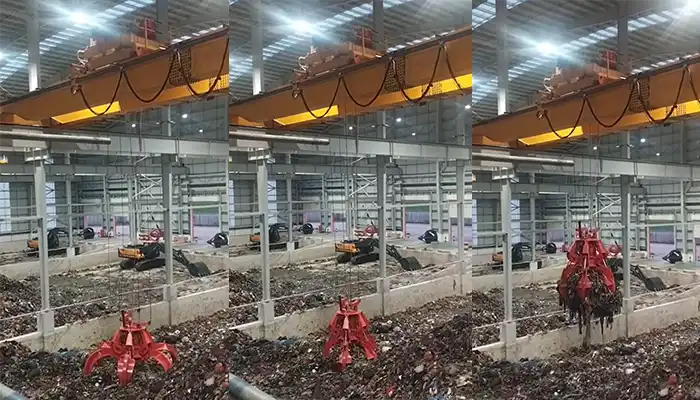
Supplied three grab bucket crane kits to Indonesia, enhancing garbage handling efficiency with high load capacity and reliable performance.
Free consultation to Confirm Parameters & Specifications and Get
Latest Crane Price & Crane Rate.
- Types of overhead cranes : _______?
- Optional: Overhead travelling crane, goliath gantry crane,Slewing jib crane, Single girder or double girder crane,small portable crane or kbk crane, etc.
- Capacity of overhead crane: _______?
- Optional: 0.25ton, 0.5 ton, 1 ton, 2 ton, 3ton, 5 ton, 10 ton,15ton, 20ton, 25 ton, 30ton,35ton, up to 550ton, etc.
- Crane span & lifting height : _______?
- Crane travelling length : _____?
- Control of overhead crane:_______?
- Optional: pendant/ remote/cabin control
- Voltage supply of overhead crane:_____?
- Eg,: 380V50/60HZ,3Phase or others,etc.
- Application/usage of crane:_______?
- Eg,: Steel mill, ,injection mold, cement,stone, concrete,granite, general manufacturing, etc.
Just leave a message via the contact form and our hoist and crane engineer will contact you with in 24working hours.
Get In Touch
